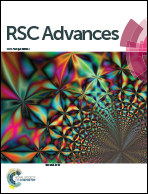Enantiomers of 3-pentylbenzo[c]thiophen-1(3H)-one: preparation and evaluation of anti-ischemic stroke activities†
Abstract
3-Pentylbenzo[c]thiophen-1(3H)-one 1 is reportedly more potent than its analogue 3-n-butylphthalide (NBP), a known anti-ischemic stroke drug. Since both 1 and NBP are molecules each bearing a chiral center, we prepared both enantiomers of 1 with high chemical and optical purity, and evaluated their biological activities in comparison with (S)- and (R)-NBP, respectively. We observed that (S)-NBP, more significantly than (R)-NBP, inhibited platelet aggregation, reduced infarct size and brain water content, improved neurobehavioral deficit, and attenuated oxidative damage and brain cortex injury, consistent with what has been reported previously. Importantly, both 1 and its enantiomers effectively inhibited ADP- or AA-induced platelet aggregation in vitro and attenuated ischemia/reperfusion (I/R)-related brain cortex injury in rats, superior to (S)-NBP. In addition, 1 and its enantiomers greatly reduced the infarct size in rat brains, comparable to (S)-NBP. Furthermore, they more effectively normalized the levels of MDA, GSH and SOD in H2O2-treated PC12 cells and I/R-induced rats than a well-known free radical scavenger edaravone (Eda) and (S)-NBP, suggesting that 1 and its enantiomers may have stronger antioxidative activity. Finally, although (R)-1 was somewhat better than (S)-1 in the protection from brain cortex damage in rats, the two enantiomers were as potent as racemate 1 in antiplatelet aggregation, antioxidation, reduction of infarct size and brain water content, as well as neurological deficit. These findings provide a solid base for further investigation of racemate 1 and its enantiomers.
![Graphical abstract: Enantiomers of 3-pentylbenzo[c]thiophen-1(3H)-one: preparation and evaluation of anti-ischemic stroke activities](/en/Image/Get?imageInfo.ImageType=GA&imageInfo.ImageIdentifier.ManuscriptID=C6RA04251A&imageInfo.ImageIdentifier.Year=2016)

 Please wait while we load your content...
Please wait while we load your content...